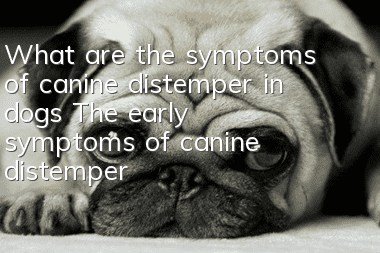What are the symptoms of canine distemper in dogs? The early symptoms of canine distemper!

Dogs have entered more and more families as pets. Our lives are happier with the company of dogs. Keeping dogs also alleviates the negative emotions of many people. Dogs have become part of our family and occupy a very important position. Once a dog gets sick, parents are very anxious. Canine distemper is a fatal disease for dogs. If it is not discovered or treated in time, it will kill the dog. So what are the symptoms of canine distemper in dogs?
The early symptoms of canine distemper:
Canine distemper is a contagious disease that affects dogs. There is a great threat to the dog's life. It is highly contagious and has a high mortality rate. Once a dog is sick, he will have a loss of appetite, low energy, and watery discharge from his eyes and nose in the early stages of canine plague. At the same time, there will be symptoms such as cough, diarrhea, stool mixed with blood and bubbles, and fever with a body temperature as high as 39.5 to 41. A small number of dogs will have convulsions and spasms.
How to treat canine distemper in the early stage?
If the dog shows the above symptoms, parents can first use canine distemper CDV test paper to test whether the dog is really suffering from canine distemper. Inexperienced parents should not blindly listen to folk remedies or rely on information on treatment. They should take their dogs to the pet hospital for treatment in a timely manner. At the same time, you can take the following measures: Keep the indoor environment ventilated and dry. If the sun is strong, do not take the dog out, as this will aggravate the condition.
For physical cooling, you can use alcohol to wipe the dog’s soles and ears for physical cooling.
In the early stage, hyperimmune serum or immunoglobulin, interferon, monoclonal antibodies, etc. can be used for emergency passive immunization.
1. Initial symptoms
The incubation period of canine distemper is generally 3 to 6 days. If it is not transmitted between the same kind, then the incubation period It could be within a month or even three months.
Once you get canine distemper, there will be watery secretions in the early stages of the disease, of course in the eyes and nose, and the dog’s body temperature will also soar to more than 40 degrees Celsius. This state is normal. It will last for 2 to 3 days.
After that, the body temperature will be close to normal temperature, and at this time many parents will think that the dog has returned to normal. In fact, this is the calm before the second temperature rise, which will last for several weeks, and It can cause inflammation of the respiratory tract and digestive tract, and dogs may also develop dry cough.
2. Mid-term symptoms
If no timely treatment is received in the early stage, the dog’s body temperature will continue to remain between 40 degrees Celsius and 41 degrees Celsius. It will return to normal over time, but most dogs will appear depressed, lose appetite, and have rapid breathing. The most important thing is that the dog’s skin will become very dry after all, and some dogs will also have symptoms such as drooling..
At this time, the dog will also have symptoms similar to colds, such as sneezing, runny nose, coughing with a lot of phlegm, and the nasal mucus is usually purulent or yellow-green, and the lungs may also be infected. The cornea will also swell and there will be more secretions. Some dogs may also develop severe anemia, oral ulcers, and canthus erosion.
Symptoms and treatments of canine distemper
3. Late symptoms
Extremely ill dogs The dogs continue to have high fevers, and their condition is further deteriorating. They can no longer open their eyes at all, and some dogs will suffer from blindness, corneal perforation or ulcers.
Some dogs will also have some neurological conditions, most of which are epilepsy or spinning in circles for no reason. Some dogs have very abnormal standing postures, unstable gaits, and are constantly chewing things. And the limbs will continue to twitch. This situation will basically last for about a month.
Treatment methods
Once a dog is diagnosed, the family should keep it in isolation from other pets, and the kennel must be thoroughly cleaned of disinfection. Because early treatment can prevent secondary infections, improve the likelihood of the dog being cured, and reduce mortality.
First, the sick dog must be injected with hyperimmune serum. This is an effective measure to remove the virus from the dog's body. It can be injected once or twice a day according to the dog's condition; then antibiotics are given to the dog. , control complications and secondary infections; and finally treat symptoms, because individual dogs are different, some dogs will have vomiting, and some dogs will have diarrhea.
Targeted treatment
Parents in the early and middle stages of canine distemper can choose to take hyperimmune serum, adding one ml per kilogram and using it for three consecutive days. After a few days, give the dog ampicillin, Bupleurum injection, and human interferon.
On the fourth day, parents can choose to use monoclonal antibodies for two consecutive days.
On the 7th and 8th days, parents can choose to use immune globulin.
On the 9th day, parents can add gentamicin or ribavirin for injection in the morning and evening. In an emergency, the symptoms of canine distemper can be eliminated and reduced, and the body temperature can also be controlled at 39 Around degrees Celsius.
On the 10th day, parents can use Qingkailing capsules or Yinqiao Jiedu tablets for their dogs.
From the 11th to the 14th day, parents can inject canine doublet and polyclonal antibodies into their dogs, and don’t forget ribavirin.
From the 15th to the 16th day, parents can inject immune globulin into their dogs once in the morning and evening. Until the 22nd day, be sure to observe the dog’s movements at any time, and thenDifferent drugs are then added for treatment.
Note that dogs already suffering from canine distemper cannot be vaccinated if there are other dogs at home. Be sure to isolate the sick dog separately to prevent infection.
- golden retriever pregnancy process
- What should I do if my dog doesn’t eat the new dog food?
- How to train an aggressive dog? Train a very aggressive dog!
- What should I do if my dog has dystocia? A must-read for emergency measures for dog dystocia!
- What's wrong with the puppy scratching the wall?
- The dangers of bathing your dog too often
- Dogs always make mistakes and never correct themselves. How do you train a dog when it makes mistakes?
- What should I do if my Husky breaks down the house? Husky training tips!
- How to train a Rottweiler, Rottweiler training tutorial!
- Samoyed Food and Feeding



